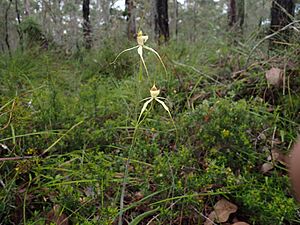Bussell's spider orchid facts for kids
Quick facts for kids Bussell's spider orchid |
|
|---|---|
 |
|
| Caladenia busselliana growing near Dunsborough | |
| Conservation status | |
| Scientific classification | |
| Genus: |
Caladenia
|
| Species: |
busselliana
|
Bussell's spider orchid, also known as Caladenia busselliana, is a special type of flower. It belongs to the orchid family. This unique plant is "endemic," meaning it naturally lives only in a small part of Western Australia. It's a very rare orchid, with only about 50 known plants left in the world.
This orchid has a straight, hairy leaf and can grow up to three pale yellow flowers. Sadly, it is in danger because its natural home is being destroyed. It also faces threats from bushfires that happen too often or not often enough.
Contents
What Does Bussell's Spider Orchid Look Like?
Bussell's spider orchid is a plant that grows from the ground. It is a "perennial" plant, which means it lives for more than two years. It's also "deciduous," so it loses its leaves at certain times. This plant is a "herb," which means it has soft stems, not woody ones like a tree.
It grows from an underground part called a "tuber," which is like a small storage organ. A single, hairy leaf grows straight up from the ground. This leaf can be about 20 to 30 centimeters (8 to 12 inches) long. It is also about 5 to 10 millimeters (0.2 to 0.4 inches) wide.
The orchid stem can grow up to 30 centimeters (12 inches) tall. It holds up to three pale yellow flowers. Each flower is quite large, about 6 to 10 centimeters (2 to 4 inches) long. They are also about 5 to 8 centimeters (2 to 3 inches) wide.
Flower Parts of the Spider Orchid
The parts of the flower that spread out are called the "lateral sepals" and "petals." These parts are wide and the sepals are thick. The special lower petal of the orchid is called the "labellum." On this orchid, the labellum is pale yellow to white. Unlike some other spider orchids, it does not have a red tip.
The sides of the labellum have thin, tooth-like parts. These are called "calli" and they have a "clubbed" end. There are also four or more rows of calli along the center of the labellum. These central calli have red tips.
Bussell's spider orchid flowers bloom between September and October. After flowering, the plant forms a dry "capsule." This capsule opens up to release many tiny seeds.
How Bussell's Spider Orchid Got Its Name
The scientific name Caladenia busselliana was first officially described in 2001. Two scientists, Stephen Hopper and Andrew Brown, gave it this name. They wrote about it in a scientific journal called Nuytsia.
The "specific epithet" (busselliana) is the second part of its scientific name. It was chosen to honor Greg Bussell. He was the person who collected the first plant specimen used for its description. This first plant is called the "type specimen."
Where Does Bussell's Spider Orchid Live?
Bussell's spider orchid likes to grow in wet, swampy areas. It can be found in forests where "jarrah" trees (Eucalyptus marginata) grow. It also lives in woodlands with "marri" trees (Corymbia calophylla).
Often, you can find this orchid growing alongside other plants. These include the green kangaroo paw (Anigozanthos viridis) and the more common swamp spider orchid (Caladenia paludosa).
This rare orchid is only known from two small areas. These areas are near the towns of Vasse and Yallingup. Both locations are at the northern end of the Leeuwin-Naturaliste ridge. This region is part of the "Swan Coastal Plain" in Western Australia.
Protecting Bussell's Spider Orchid
Bussell's spider orchid is considered "endangered." This means it is at a very high risk of disappearing forever. It is protected by important laws in Australia.
The Australian Government's Environment Protection and Biodiversity Conservation Act 1999 (EPBC Act) lists it as endangered. The Western Australian Wildlife Conservation Act 1950 also classifies it as "rare flora." These laws help protect the orchid and its habitat.



